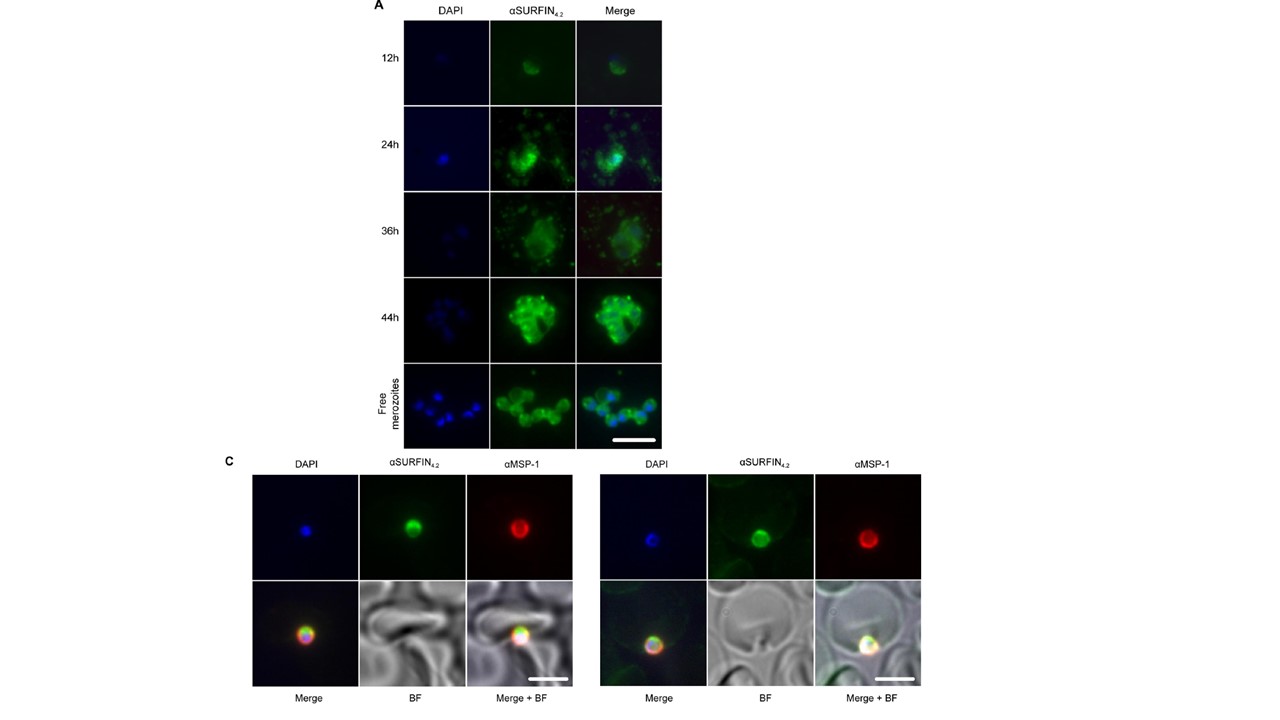SURFIN4.2 localizes at the apical end and surface of the merozoites. (A) IFA on a time course, showing SURFIN4.2 labeling throughout the asexual cycle inside the RBCs and after schizont rupture. (B) IFA on double-labeled schizonts. (C) IFA on double-labeled invading merozoites upon apical attachments (upper panel) and during active invasion into the nascent PV (lower panel). SURFIN4.2 is shown in green, surface markers (MSP-1 and MSP-3) and microneme markers (EBA-175 and AMA-1) are shown in red. Scale bar represents 5μm. the protein expression increased with cycle progression. Signal was weak during ring stages (12 hours) and was mostly associated with the PV (A) while trophozoite stages (24 and 36 hours), showed a stronger signal associated again with the PV as well as with vesicles (presumably MC) in the RBC cytoplasm (A). Schizont stages showed a clear association between the forming merozoites and the SURFIN4.2 protein, staining was clearly confined to the apical end and the surface of the merozoites (A). Co-labeling of schizonts with SURFIN4.2 and the merozoite surface markers MSP-1 and MSP-3 showed significant signal overlapping. Co-labeling with the microneme markers EBA-175 and AMA-1, showed the staining patterns were in close proximity, but no complete overlapping was observed (B). Further, SURFIN4.2 labeling was localized more apically with respect to the microneme labeling. These observations suggested that SURFIN4.2 was localized both at the surface and at the apical end of the merozoite inside an organelle different from the micronemesץ When SURFIN4.2 localization was assessed during early events of the invasion process, protein was again observed at the surface and more importantly at the apical end of the merozoite. Protein was observed on the merozoite apical end during attachment to the RBC (C, left panel) and during active invasion into the nascent PV (C, right panel), suggesting a role of SURFIN4.2 during these early events.
Quintana MDP, Ch'ng JH, Zandian A, Imam M, Hultenby K, Theisen M, Nilsson P, Qundos U, Moll K, Chan S, Wahlgren M. SURGE complex of Plasmodium falciparum in the rhoptry-neck (SURFIN4.2-RON4-GLURP) contributes to merozoite invasion. PLoS One. 2018 Aug 9;13(8):e0201669.
Other associated proteins
| PFID | Formal Annotation |
|---|---|
| PF3D7_0731500 | erythrocyte binding antigen-175 |
| PF3D7_1035400 | merozoite surface protein 3 |
| PF3D7_1133400 | apical membrane antigen 1 |
